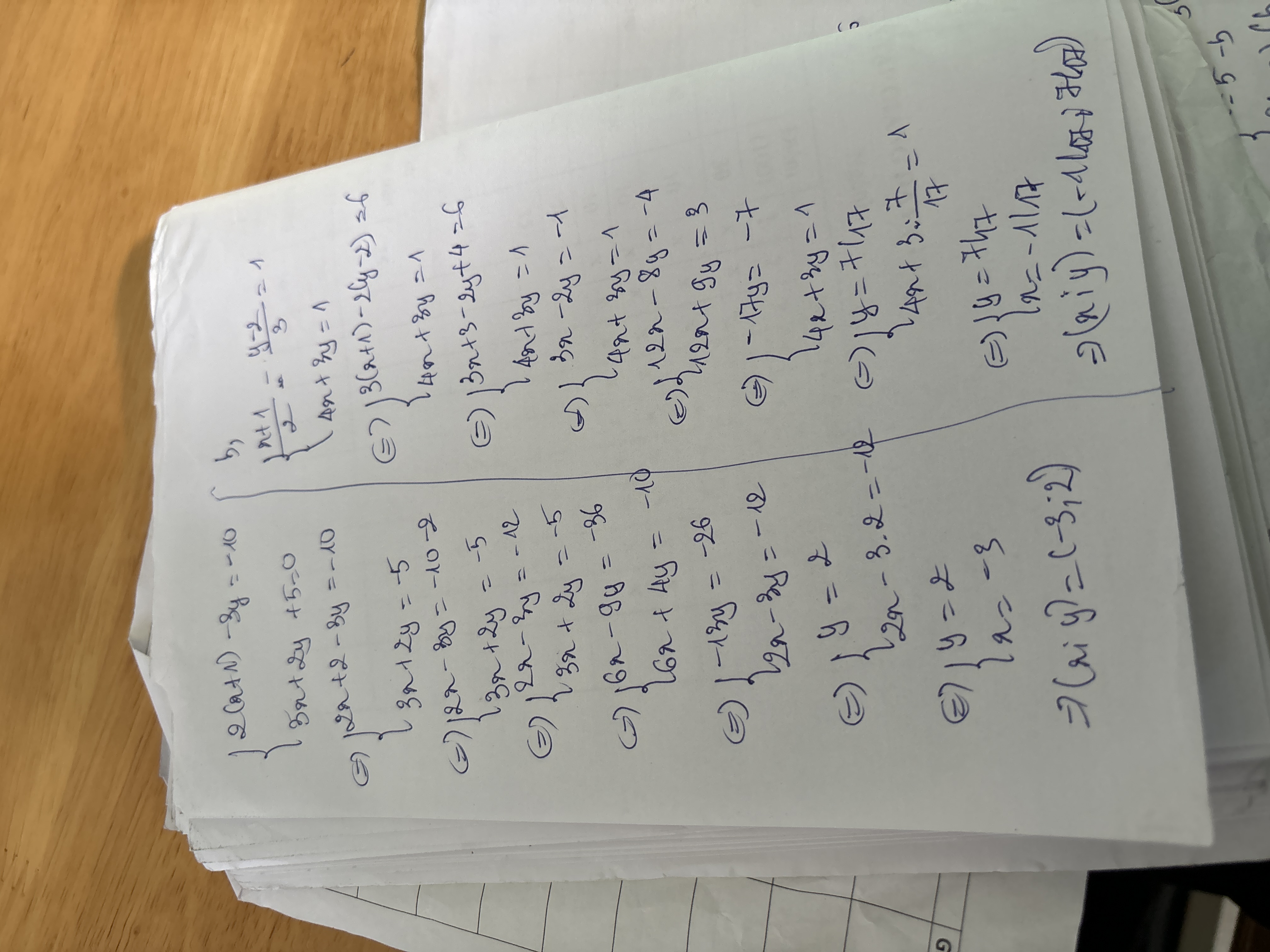Hãy nhập câu hỏi của bạn vào đây, nếu là tài khoản VIP, bạn sẽ được ưu tiên trả lời.

Ta có:
2/(-1) ≠ 1/1 (-2 ≠ 1)
⇒ Hệ phương trình đã cho có nghiệm duy nhất

b: \(\dfrac{3}{2}< >\dfrac{2}{-3}\)
nên hệ có 1 nghiệm duy nhất
c: 3/2<>0/1
nên hệ có 1 nghiệmduy nhất
d: 0/1<>-1/-1
nên hệ có 1 nghiệm duy nhất
e: 1/2=2/4<>3/1
nên hệ ko có nghiệm
f: 1:1/2=1:1/2=1:1/2
nên hệ có vô số nghiệm

\(1,\Leftrightarrow\left\{{}\begin{matrix}x=y+5\\2y+10+y=11\end{matrix}\right.\Leftrightarrow\left\{{}\begin{matrix}x=\dfrac{16}{3}\\y=\dfrac{1}{3}\end{matrix}\right.\\ 2,\Leftrightarrow\left\{{}\begin{matrix}3x=1-2y\\1-2y+y=2\end{matrix}\right.\Leftrightarrow\left\{{}\begin{matrix}x=1\\y=-1\end{matrix}\right.\\ 3,\Leftrightarrow\left\{{}\begin{matrix}x=y+2\\3y+6+2y=11\end{matrix}\right.\Leftrightarrow\left\{{}\begin{matrix}x=3\\y=1\end{matrix}\right.\)

a.
\(\Leftrightarrow\left\{{}\begin{matrix}\left(2x-y\right)^2-3\left(2x-y\right)=0\\x+2y=0\end{matrix}\right.\)
\(\Leftrightarrow\left\{{}\begin{matrix}\left(2x-y\right)\left(2x-y-3\right)=0\\x+2y=0\end{matrix}\right.\)
\(\Leftrightarrow\left[{}\begin{matrix}\left\{{}\begin{matrix}2x-y=0\\x+2y=0\end{matrix}\right.\\\left\{{}\begin{matrix}2x-y-3=0\\x+2y=0\end{matrix}\right.\end{matrix}\right.\)
\(\Leftrightarrow\left[{}\begin{matrix}\left\{{}\begin{matrix}x=0\\y=0\end{matrix}\right.\\\left\{{}\begin{matrix}x=\dfrac{6}{5}\\y=-\dfrac{3}{5}\end{matrix}\right.\end{matrix}\right.\)
b.
ĐKXĐ: \(\dfrac{2x-y}{x+y}>0\)
Đặt \(\sqrt{\dfrac{2x-y}{x+y}}=t>0\) pt đầu trở thành:
\(t+\dfrac{1}{t}=2\Leftrightarrow t^2-2t+1=0\)
\(\Leftrightarrow t=1\Leftrightarrow\sqrt{\dfrac{2x-y}{x+y}}=1\)
\(\Leftrightarrow2x-y=x+y\Leftrightarrow x=2y\)
Thay xuống pt dưới:
\(6y+y=14\Rightarrow y=2\)
\(\Rightarrow x=4\)

a. Thay m = 1 ta được
\(\left\{{}\begin{matrix}x+2y=4\\2x-3y=1\end{matrix}\right.\Leftrightarrow\left\{{}\begin{matrix}2x+4y=8\\2x-3y=1\end{matrix}\right.\Leftrightarrow\left\{{}\begin{matrix}y=1\\x=2\end{matrix}\right.\)
b, Để hpt có nghiệm duy nhất khi \(\dfrac{1}{2}\ne-\dfrac{2}{3}\)*luôn đúng*
\(\left\{{}\begin{matrix}2x+4y=2m+6\\2x-3y=m\end{matrix}\right.\Leftrightarrow\left\{{}\begin{matrix}7y=m+6\\x=m+3-2y\end{matrix}\right.\Leftrightarrow\left\{{}\begin{matrix}y=\dfrac{m+6}{7}\\x=m+3-2\dfrac{m+6}{7}\end{matrix}\right.\)
\(\Leftrightarrow x=m+3-\dfrac{2m+12}{7}=\dfrac{7m+21-2m-12}{7}=\dfrac{5m+9}{7}\)
Ta có : \(\dfrac{m+6}{7}+\dfrac{5m+9}{7}=-3\Rightarrow6m+15=-21\Leftrightarrow m=-6\)
\(\left\{{}\begin{matrix}x+2y=m+3\\2x-3y=m\end{matrix}\right.\)
\(a,Khi.m=1\Rightarrow\left\{{}\begin{matrix}x+2y=1+3\\2x-3y=1\end{matrix}\right.\)
\(\Leftrightarrow\left\{{}\begin{matrix}x=4-2y\\2\left(4-2y\right)-3y=1\end{matrix}\right.\Rightarrow\left\{{}\begin{matrix}x=4-2y\\8-4y-3y=1\end{matrix}\right.\Rightarrow\left\{{}\begin{matrix}x=4-2y\\7y=7\end{matrix}\right.\Rightarrow\left\{{}\begin{matrix}y=1\\x=2\end{matrix}\right.\rightarrow\left(x,y\right)=\left(2,1\right)\)
\(b,\left\{{}\begin{matrix}x+2y=m+3\\2x-3y=m\end{matrix}\right.\Leftrightarrow\left\{{}\begin{matrix}2x+4y=2m+6\left(1\right)\\2x-3y=m\left(2\right)\end{matrix}\right.\)
\(\left(1\right),\left(2\right)\Rightarrow\left\{{}\begin{matrix}7y=m+6\\x+2y=m+3\end{matrix}\right.\)
\(\Leftrightarrow\left\{{}\begin{matrix}x=\dfrac{5m+9}{7}\\y=\dfrac{m+6}{7}\end{matrix}\right.\Rightarrow\) HPT có no duy nhất
\(\left(x,y\right)=\left(\dfrac{5m+9}{7};\dfrac{m+6}{7}\right)\)
\(x+y=-3\)
\(\dfrac{5m+9}{7}+\dfrac{m+6}{7}=-3\)
\(\Leftrightarrow5m+9+m+6=-21\)
\(\Leftrightarrow6m=-36\Rightarrow m=-6\)
Với m = -6 thì hệ pt có no duy nhất TM x + y = -3

\(1,\Leftrightarrow\left\{{}\begin{matrix}x=2y+4\\-4y-8+5y=-3\end{matrix}\right.\Leftrightarrow\left\{{}\begin{matrix}x=2\cdot5+4=14\\y=5\end{matrix}\right.\\ 2,\Leftrightarrow\left\{{}\begin{matrix}5x-30+6x=3\\y=10-2x\end{matrix}\right.\Leftrightarrow\left\{{}\begin{matrix}x=3\\y=4\end{matrix}\right.\\ 3,\Leftrightarrow\left\{{}\begin{matrix}x=4-2y\\6y-12+y=7\end{matrix}\right.\Leftrightarrow\left\{{}\begin{matrix}x=-\dfrac{10}{7}\\y=\dfrac{19}{7}\end{matrix}\right.\)

a: \(\sqrt{x^2+6x+9}=\sqrt{11+6\sqrt{2}}\)
=>\(\sqrt{\left(x+3\right)^2}=\sqrt{\left(3+\sqrt{2}\right)^2}\)
=>\(\left|x+3\right|=\left|3+\sqrt{2}\right|=3+\sqrt{2}\)
=>\(\left[{}\begin{matrix}x+3=3+\sqrt{2}\\x+3=-3-\sqrt{2}\end{matrix}\right.\Leftrightarrow\left[{}\begin{matrix}x=\sqrt{2}\\x=-6-\sqrt{2}\end{matrix}\right.\)
b: \(\left\{{}\begin{matrix}2x-y=4\\x+2y=-3\end{matrix}\right.\)
=>\(\left\{{}\begin{matrix}4x-2y=8\\x+2y=-3\end{matrix}\right.\Leftrightarrow\left\{{}\begin{matrix}4x-2y+x+2y=8-3\\2x-y=4\end{matrix}\right.\)
=>\(\left\{{}\begin{matrix}5x=5\\y=2x-4\end{matrix}\right.\Leftrightarrow\left\{{}\begin{matrix}x=1\\y=2\cdot1-4=-2\end{matrix}\right.\)


\(\left\{{}\begin{matrix}2x-y=1\\x-2y=-1\end{matrix}\right.\)
Ta có:
\(D=-4+1=-3\ne0\)
\(D_x=-2-1=-3\ne0\)
\(D_y=-2-1=-3\ne0\)
Vậy Hệ phương trình đã cho có 1 nghiệm duy nhất.